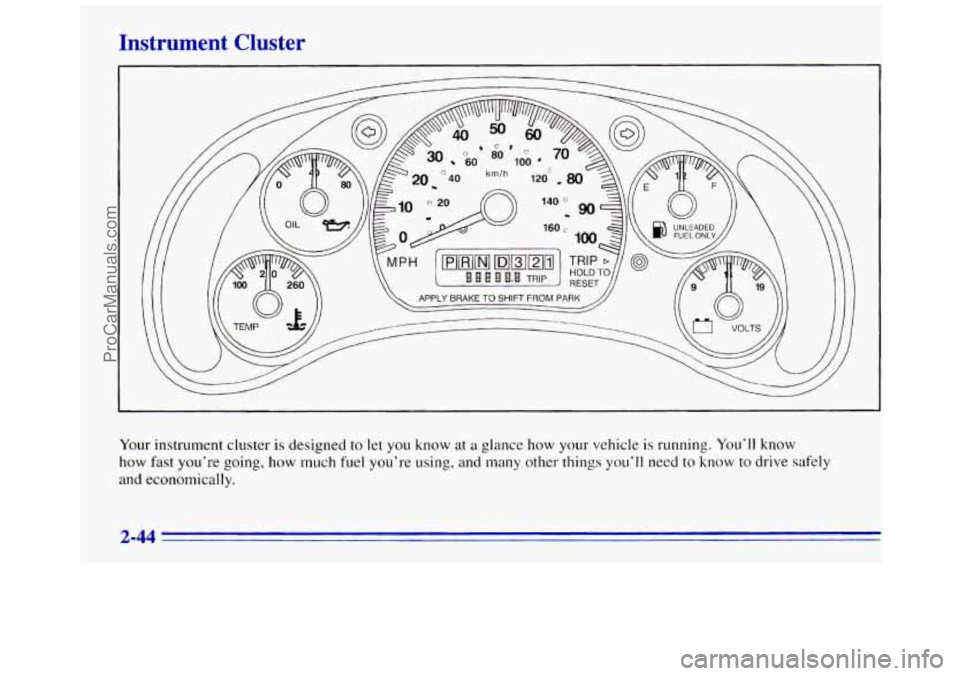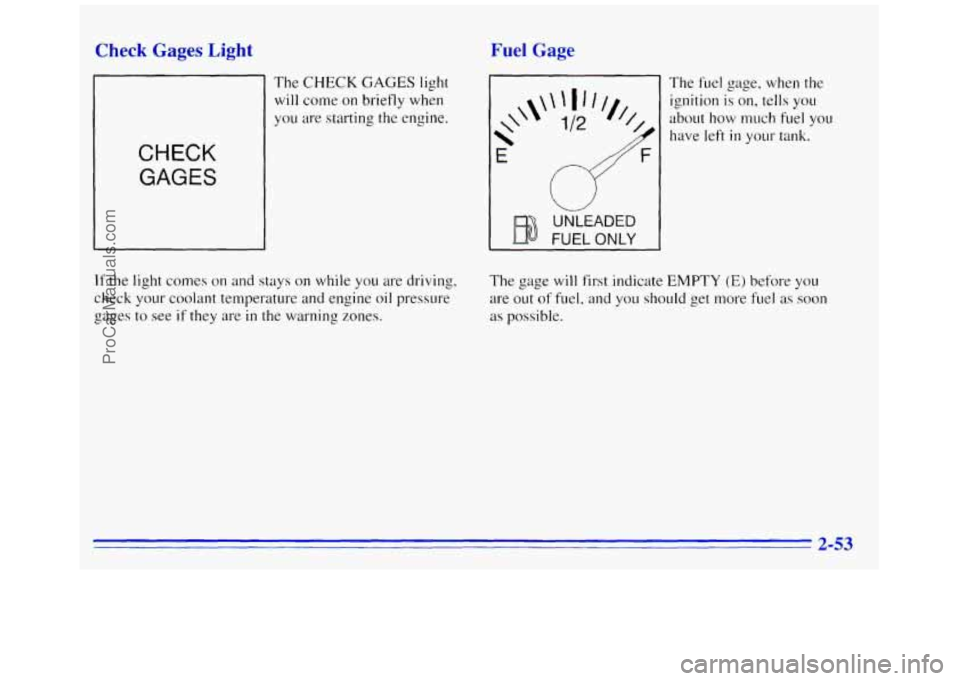1996 GMC SAVANA fuel
[x] Cancel search: fuelPage 7 of 372

Vehicle Symbols
These are some of the symbols you may find on your vehicle.
For example,
these symbols
are
used on an
original battery:
POSSIBLE A
CAUTION
INJURY
PROTECT EYES BY
SHIELDING
CAUSTIC
ACID COULD BATTERY
CAUSE
BURNS
AVOID
SPARKS
OR
FLAMES
SPARK
OR ,111,
COULD FLAME
EXPLODE BATTERY
These symbols are important for you and
your passengers
whenever your
vehicle
is
driven:
DOOR LOCK
FASTEN SEAT
BELTS
POWER
WINDOW
These symbols have
to do with
your lights:
SIGNALS e
TURN
RUNNING
* 0
DAYTIME . .
LAMPS -**
FOG LAMPS $0
These symbols
are
on some of
your controls:
WINDSHIELD
WIPER
WINDSHIELD DEFROSTER
VENTILATING FAN
These symbols
are used on
warning and
indicator lights:
COOLANT -
TEMP -
CHARGING I-1
BATTERY
SYSTEM
BRAKE
(a)
ENGINE OIL w,
PRESSURE
ANTI-LOCK
(@)
BRAKES
Here are some
other symbols
you may see:
FUSE
LIGHTER
m
HORN )cr
SPEAKER
b
FUEL ha
V
ProCarManuals.com
Page 74 of 372

Engine Coolant Heater (Option)
In very cold weather, 0°F (- 18°C) or colder, the engine
coolant heater can help. You’ll get easier starting and
better fuel economy during engine warm-up. Usually,
the coolant heater should be plugged
in a minimum of
four hours prior to starting your vehicle.
To use the coolant heater:
1. Turn off the engine.
2. Open the hood and unwrap the electrical cord.
3. Plug it into a normal, grounded I IO-volt AC outlet.
A CAUTION:
Plugging the cord into an ungrounded outlet
l could cause an electrical shock. Also, the wrong
kind
of extension cord could overheat and cause
a tire. You could be seriously injured. Plug the
1 cord into a properly grounded three-prong
110-volt
AC outlet. If the cord won’t reach, use a
l heavy-duty three-prong extension cord rated for
at least 15 amps.
I
4. After you’ve used the coolant heater, be SLUT to store
the cord
as it was before to keep it away from moving
engine parts.
If you don’t, it could be damaged.
How
long should you keep the coolant heater plugged
in’? The answer depends on the outside temperature, the
kind
of oil you have, and some other things. Instead of
trying to list everything here, we ask that you contact
a
GM dealer in the area where you’ll be parking yo~~r
vehicle. The dealer can give
you the best advice for that
particular area.
2-16
ProCarManuals.com
Page 77 of 372

DRIVE (D): This position is for normal driving. If you
need more power for passing, and you’re:
Going less than about 35 mph (56 km/h), push your
accelerator pedal about halfway down.
Going about 35 mph (56 km/h) or more, push the
accelerator all the way down.
You’ll shift down to the next gear and have more power.
You should use DRIVE
(D) (or, as you need to, a lower
gear) when towing
a trailer. Operating your vehicle in
DRIVE (D) when towing a trailer will minimize heat
build-up and extend the life of your transmission.
THIRD (3): This position is also used for normal
driving, however,
it offers more power and lower fuel
economy than DRIVE
(D). You should use THIRD (3)
when carrying a heavy load or driving on steep hills.
SECOND (2): This position gives you more power
but lower fuel economy.
You can use SECOND (2)
on hills. It can help control your speed as you go
down steep mountain roads, but
then you would also
want to use your brakes off and on. If you manually
select
SECOND (2), the transmission will drive in
second gear. You may use this feature for reducing
torque to the rear wheels when
you are trying to start
your vehicle from a stop on slippery road surfdces.
FIRST (1): This position gives you even more power
(but lower fuel economy) than SECOND
(2). You can
use
it on very steep hills, or in deep snow or mud. If
the selector lever is put in FIRST ( 1)’ the transmission
won’t shift into first gear
until the vehicle is going
slowly enough.
w
NOTICE:
If your rear wheels can’t rotate, don’t try to
drive. This might happen if you are stuck in
very deep sand or mud
or are up against a solid
object. You could damage your transmission.
Also, if you stop when going uphill, don’t hold
your vehicle there with only the accelerator
pedal. This could overheat and damage the
transmission. Use your brakes or shift into
PARK (P) to hold your vehicle in position on
a hill.
2-19
ProCarManuals.com
Page 102 of 372

Instrument Cluster
Your instrument cluster is designed to let you know at a glance how your vehicle is running. You’ll know
how fast you’re going, how much fuel you’re using, and many other things you’ll need to know to drive safely
and econo~~~ically.
2-44
ProCarManuals.com
Page 108 of 372

Malfunction Indicator Lamp (Service Engine Soon Light) (Gasoline Engine)
Your vehicle is equipped
with a computer which
monitors operation of the
-
SERVICE
ENGINE SOON
fuel, ignition and emission
control systems.
This system is called
OBD I1 (On-Board
Diagnostics-Second Generation) and is intended to
assure that emissions are at acceptable levels for the
life
of the vehicle, helping to produce a cleaner
environment. The SERVICE ENGINE SOON light
comes on to indicate that there is a problem and service
is required. Malfunctions
often will be indicated by the
system before any problem
is apparent, which may
prevent more serious damage
to your vehicle. This
system is also designed to assist your service technician
in correctly diagnosing any malfunction.
NOTICE:
If you keep driving your vehicle with this light
on, after a while, your emission controls may not
work as well, your fuel economy may not be as
good and your engine may not run as smoothly.
This could lead to costly repairs that may not be
covered by your warranty.
This light should come on, as a check to show you it is
working, when the ignition is on and the engine is not
running.
If the light doesn’t come on, have it repaired.
This light will also come on during a malfunction in
one
of two ways:
0
0
Light Flashing -- A misfire condition has been
detected.
A misfire increases vehicle emissions and
may damage the emission control system on your
vehicle. Dealer or qualified service center diagnosis
and service is required.
Light On Steady -- An emission control system
malfunction has been detected on your vehicle.
Dealer or qualified service center diagnosis and
service may be required.
2-50
ProCarManuals.com
Page 109 of 372

If the Light Is Flashing Are you low on fuel‘?
The following may prevent more serious damage to
your vehicle:
Reduce vehicle speed.
Avoid hard accelerations.
0 Avoid steep uphill grades.
If towing a trailer, reduce the amount of cargo being
hauled as soon as
it is possible.
If the light stops flashing and remains on steady, see “If
the Light Is On Steady“ following.
If the light continues to flash, when it is safe to do so.
stop the vehicle. Put your vehicle in PARK (P). Turn the
key
off, wait at least 10 seconds and restart the engine.
If the light remains on steady, see
“If the Light Is On
Steady” following.
If the light is still flashing follow the
previous steps, and drive the vehicle to your dealer or
qualified service center for service.
If’ the Light Is On Steady
You may be able to correct the emission system
malfunction by considering the following:
Did
you just drive through a deep puddle of water?
If so, your electrical system may be wet. The condition
will usually be c0rrecte.d when the electrical system
dries out. A few driving trips should turn the light off. As
your engine starts to run
out of fuel, your engine may
not run as efficiently as designed since
s~nall amounts of
air are sucked into the fuel line causing a misfire. The
system can detect this. Adding fuel should correct this
condition. Make sure to install the fuel cap properly.
It
will take a few driving trips to turn the light off.
Have you recently changed brands of fuel‘?
If so, be sure to fuel your vehicle with quality fuel (see
“FLE~”
in the Index). Poor fuel quality will cause your
engine not to
run as efficiently as designed. You may
notice this as stalling after start-up, stalling when
you put
the vehicle into gear, misfiring, hesitation on acceleration
or stumbling on acceleration. (These conditions may go
away once the engine is warmed up.) This will be
detected by the system and cause the light to turn on.
If you experience this condition, change the fuel brand
you use. It will require at least one full tank of the
proper fuel to
turn the light off.
If none
of the above steps have made the light turn off,
have your dealer or qualified service center check the
vehicle. Your dealer has the proper test equipment and
diagnostic tools to
fix any mechanical or electrical
problems that
may have developed.
2-51
ProCarManuals.com
Page 111 of 372

Check Gages Light
The CHECK GAGES light
will come on briefly when
you are starting
the engine.
CHECK
GAGES
Fuel Gage
*
\\'
E
FUEL ONLY
UNLEADED
The fuel gage, when the
ignition is on, tells you
about how much
fuel you
have left
in your tank.
If the light comes on and stays on while you are dri\iing,
check your coolant temperature and engine oil pressure
gages to see
if they are in the warning zones. The
gage will first indicate
EMPTY (E) before you
are out
of fuel, and you should get more fuel as soon
as
possible.
2-53
ProCarManuals.com
Page 112 of 372

Listed are four situations you may experience with your
fuel gage:
0
0
0
0
At the gas station, the fuel pump shuts off before the
gage reads
FULL (F).
It takes a little more or less fuel to fill up than the
fuel gage indicated. For example, the gage may have
indicated the tank was half
full, but it actually took a
little more or less than half the tank’s capacity to fill
the tank.
The gage moves a little when
you turn a corner or
speed
up.
The gage doesn’t go back to EMPTY (E) when you
turn off the ignition.
None
of these indicate a problem with the fuel gage.
Engine Coolant Temperature Gage
This gage shows the
If the gage pointer moves /I,
engine coolant temperature.
o/ into the red area your
260 engine is too hot!
TEMP -FA mr
It means that your engine coolant has overheated. If you
have been operating your vehicle under normal
operating conditions, you should pull off the road, stop
your vehicle, and
turn off the engine as soon as possible.
In “Problems on the Road,” this manual shows what to
do. See ”Engine Overheating”
in the Index.
2-54
ProCarManuals.com